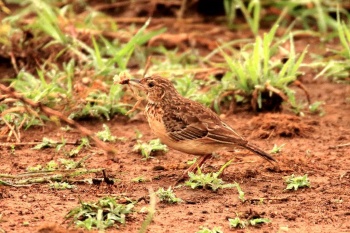- Mirafra rufocinnamomea
Identification
Length 14-15 cm, mass 21-32 g.
Similar to the Rufous-naped Lark, but smaller and darker with rufous-edged wings. Tail is distinctive and a key identification feature, being narrow, often appearing untidy, and having dark brown central rectrices and rufous outer ones.
Variation
Some subspecies are very dark above
Distribution
Sub-Saharan Africa:
Western Africa: Mauritania, Senegal, The Gambia, Guinea-Bissau, Mali, Liberia, Ivory Coast, Burkina Faso, Ghana, Togo, Benin, Nigeria, Niger, Chad, Cameroon, Central African Republic, Equatorial Guinea, Gabon, Democratic Republic of Congo, Angola and Zaire
Eastern Africa: Sudan, South Sudan, Ethiopia, Somalia, Kenya, Uganda, Rwanda, Burundi, Tanzania, Zambia, Mozambique and Malawi
Southern Africa: Namibia, Botswana, Zimbabwe, South Africa, KwaZulu-Natal and eSwatini.
Taxonomy
Subspecies
Considerable geographic variation; 15 subspecies have been described[1]:
- M. r. buckleyi: Southern Mauritania and Senegal to northern Cameroon
- M. r. serlei: South-eastern Nigeria
- M. r. tigrina: Eastern Cameroon to northern Zaire
- M. r. furensis: Southwestern Sudan
- M. r. sobatensis: Northeastern South Sudan
- M. r. torrida: Southeastern Sudan and southeastern Ethiopia south to central Uganda, central Kenya, and central Tanzania
- M. r. rufocinnamomea: North-western and central Ethiopia
- M. r. omoensis: South-western Ethiopia (Omo to Madji and Baro rivers)
- M. r. kawirondensis: Eastern Zaire to western Uganda and western Kenya
- M. r. fischeri: Eastern Angola to southern Somalia, eastern Kenya, Tanzania and northern Mozambique
- M. r. schoutedeni: Gabon to Central African Republic, western Zaire and north-eastern Angola
- M. r. lwenarum: Northern Zambia (Balovale)
- M. r. smithersi: Zambia to Zimbabwe, north-eastern Botswana and northern Transvaal
- M. r. mababiensis: Western Zambia to central Botswana
- M. r. pintoi: Eastern Transvaal to north-eastern Natal, eSwatini and southern Mozambique
Habitat
Grasslands and grassy openings in woodlands and savanna.
Behaviour
Usually solitary or in pairs.
Diet
Forages on the ground for invertebrates and seeds.
Breeding
Monogamous and territorial. The nest is a domed or partly domed structure built of grass on the ground. Two to three eggs are laid (October to April in southern Africa).
Action
Display flight is distinctive if witnessed - two to five bursts of wing-clapping (prrrrt prrrt-rrrt), sometimes followed by a thin, barely audible whistle, delivered as the bird circles in an undulating flight.
References
- Clements, J. F., T. S. Schulenberg, M. J. Iliff, D. Roberson, T. A. Fredericks, B. L. Sullivan, and C. L. Wood. 2017. The eBird/Clements checklist of birds of the world: v2017, with updates to August 2017. Downloaded from http://www.birds.cornell.edu/clementschecklist/download/
- Hockey, PAR, WRJ Dean, and PG Ryan, eds. 2005. Roberts' Birds of Southern Africa. 7th ed. Cape Town: John Voelcker Bird Book Fund. ISBN 978-0620340533
- Birdforum thread showing one of the dark forms of Flappet Lark
Recommended Citation
- BirdForum Opus contributors. (2025) Flappet Lark. In: BirdForum, the forum for wild birds and birding. Retrieved 9 May 2025 from https://www.birdforum.net/opus/Flappet_Lark





